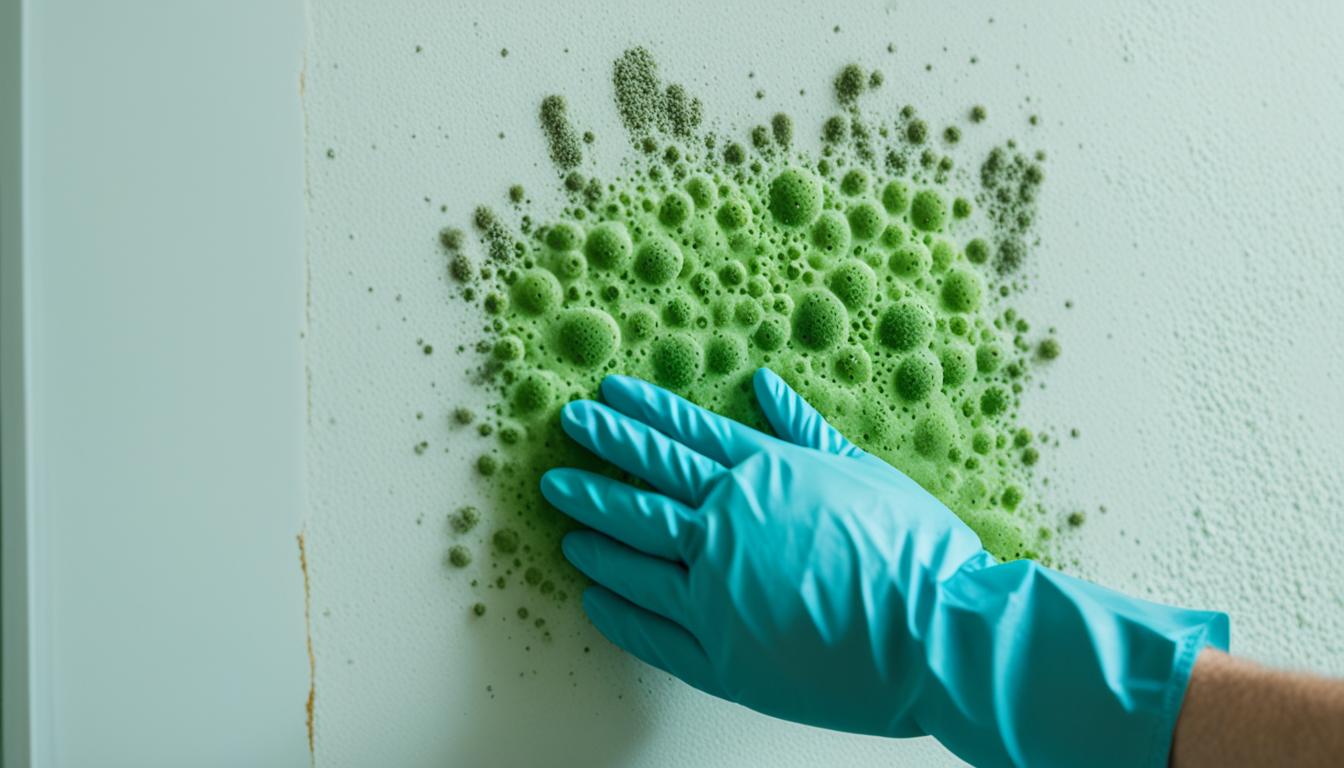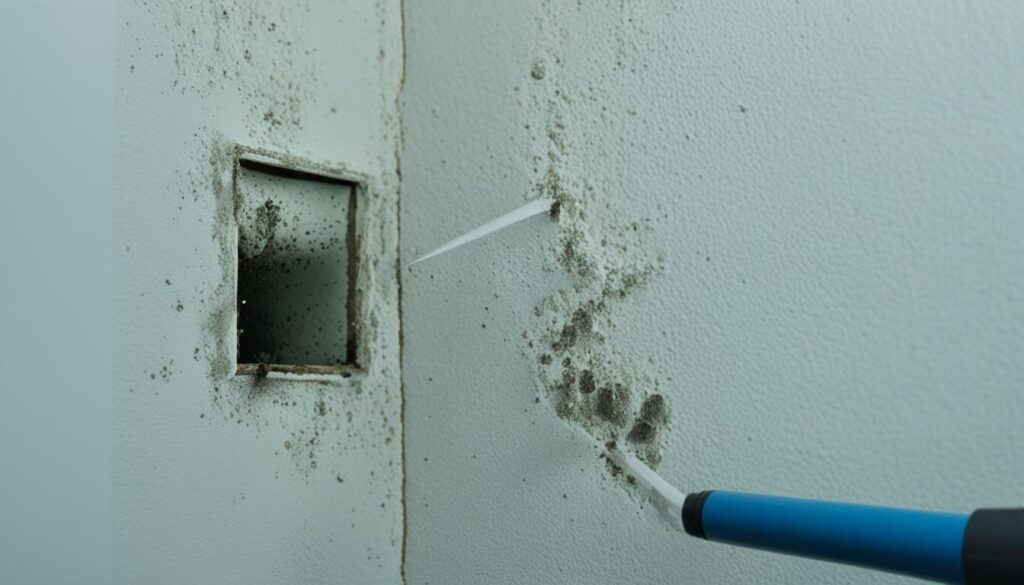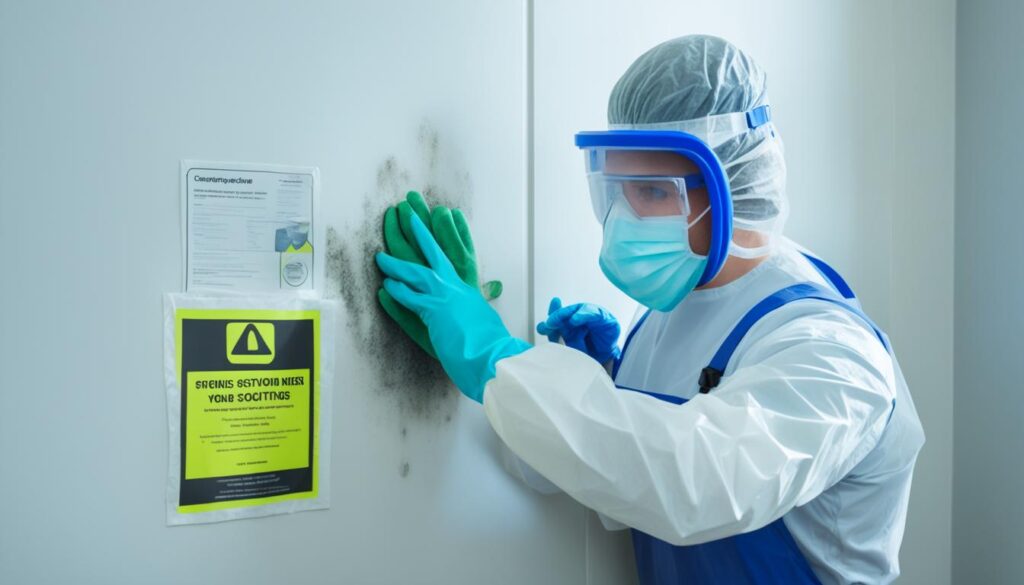
Persistent Mold Issue? Steps to Take When Mold Returns
Are you frustrated with a persistent mold problem in your home? Despite your efforts to remove it, does the mold keep coming back? Don’t worry, you’re not alone. Dealing with recurring mold can be challenging, but there are steps you can take to address the issue effectively and prevent further regrowth.
Mold not only damages your property but also poses health risks to you and your family. It’s crucial to understand the causes of mold regrowth and implement preventive measures. Whether you’re a homeowner or a renter, having the right knowledge and guidance is essential to maintain a mold-free environment.
At Your Mold Prevention Experts, we understand the frustration of dealing with recurring mold. That’s why we’ve compiled expert tips and guidance to help you combat mold and prevent its regrowth. In this article, we’ll discuss effective strategies to deal with persistent mold problems in your home.
Key Takeaways:
- Recurring mold can be addressed by understanding its causes and implementing preventive measures.
- Identifying problem areas prone to mold growth is crucial in controlling its regrowth.
- Practical tips and techniques can be followed to prevent mold from coming back.
- Knowing the correct techniques for mold removal ensures its complete elimination.
- Seeking professional assistance from trusted mold experts can provide comprehensive assessments and remediation solutions.
Understanding the Causes of Mold Regrowth
To effectively address persistent mold growth in your home, it is crucial to understand the underlying causes that contribute to its regrowth. By identifying these factors, you can implement appropriate mold growth solutions, prevent mold regrowth, and stop mold reoccurrence.
Common Causes of Mold Regrowth:
- Poor ventilation: Insufficient airflow in enclosed spaces can create favorable conditions for mold to thrive. Areas with high humidity, such as bathrooms and basements, are particularly susceptible.
- Moisture intrusion: Leaks in pipes, roofs, or windows provide a constant source of moisture that promotes mold growth. Even small amounts of water can contribute to the regrowth of mold.
- Inadequate drying: Improperly drying areas affected by water damage or flooding can leave residual moisture, providing an ideal environment for mold to proliferate.
- High humidity levels: Excessive humidity in the air, whether due to inefficient air conditioning or naturally humid climates, can create favorable conditions for mold growth.
- Poor insulation: Inadequate insulation in walls, floors, or ceilings can lead to condensation and an increase in humidity, creating an environment where mold can flourish.
Preventing mold regrowth requires addressing these underlying causes and implementing proactive measures to create an environment that discourages mold growth.
Insightful Quote: “By tackling the root causes of mold growth, homeowners can effectively prevent regrowth and ensure a mold-free living environment.” – Dr. Emily Thompson, Mold Prevention Expert
Preventing Mold Regrowth:
Here are essential strategies to prevent mold regrowth and stop it from coming back:
- Improve ventilation: Enhance airflow by opening windows, using exhaust fans, and installing proper ventilation systems. This helps to reduce moisture levels and prevent mold growth.
- Repair leaks promptly: Address any leaks or water intrusions immediately. Fixing the source of moisture prevents mold from finding an environment suitable for growth.
- Ensure proper drying: Thoroughly dry areas affected by water damage or flooding within 24-48 hours. Use dehumidifiers and fans to expedite the drying process.
- Monitor humidity levels: Regularly check and maintain appropriate humidity levels (around 30-50%) using dehumidifiers or HVAC systems with a humidity control feature.
- Improve insulation: Adequately insulate walls, floors, and ceilings to reduce condensation and prevent the formation of moisture-prone areas that encourage mold growth.
By implementing these mold prevention strategies, you can effectively address the causes of mold regrowth and create a healthier living environment for you and your family.
| Causes of Mold Regrowth | Prevention Measures |
|---|---|
| Poor ventilation | Improve airflow by opening windows and using exhaust fans. |
| Moisture intrusion | Promptly repair leaks and address water intrusions. |
| Inadequate drying | Thoroughly dry areas affected by water damage within 24-48 hours. |
| High humidity levels | Monitor and maintain appropriate humidity levels using dehumidifiers. |
| Poor insulation | Improve insulation to reduce condensation and moisture-prone areas. |
Identifying Problem Areas in Your Home
When it comes to dealing with recurring mold, one of the first steps is to identify problem areas in your home that are prone to mold growth. By recognizing these areas and implementing effective control measures, you can prevent mold from coming back and ensure a mold-free living environment.
Here are some mold prevention tips to help you identify and address problem areas:
- Inspect areas with high moisture levels, such as bathrooms, kitchens, and basements. Look for signs of water leaks, condensation, or dampness.
- Check for any ongoing plumbing issues, such as leaking pipes or faucets. These can contribute to excessive moisture buildup and promote mold growth.
- Examine your windows and doors for any gaps or cracks that may allow water to seep in during rain or snowfall. Repair or replace any damaged seals to prevent water intrusion.
- Assess your ventilation systems, including exhaust fans and air ducts. Improper ventilation can lead to moisture buildup, creating an ideal environment for mold to thrive.
- Inspect your roof for any leaks or damaged shingles. Water infiltration from the roof can lead to mold growth in your attic or upper floors.
By taking these proactive measures, you can identify and rectify problem areas in your home that contribute to recurring mold growth. Remember, effective mold control starts with prevention.
| Problem Areas | Solutions |
|---|---|
| Bathrooms | Ensure proper ventilation, fix leaks and drips, clean and dry surfaces regularly. |
| Kitchens | Use exhaust fans while cooking, wipe down countertops and sink areas, repair any plumbing issues. |
| Basements | Control humidity levels with dehumidifiers, seal cracks in walls and floors, improve ventilation. |
| Attics | Fix roof leaks, increase insulation, promote proper air circulation. |
Expert Tip:
Pay attention to areas where you have previously encountered mold issues. These spots are more likely to experience recurring mold growth. Take extra precautions in these areas to prevent mold from coming back.

Implementing Mold Prevention Measures
Preventing mold from coming back is essential for maintaining a healthy living environment. By implementing effective mold prevention measures, you can create an inhospitable environment for mold growth. Here are some practical tips and techniques to help you keep mold at bay:
1. Control Moisture Levels
Moisture is one of the primary factors that contribute to mold growth. To prevent mold from returning, it’s crucial to control moisture levels in your home. Here’s what you can do:
- Repair any leaks in pipes, faucets, or roofs promptly.
- Ensure proper ventilation in high-moisture areas like bathrooms and kitchens.
- Use dehumidifiers to reduce humidity levels in damp spaces.
- Regularly check and clean your gutters to prevent water accumulation.
2. Improve Air Circulation
Poor air circulation can create a stagnant environment that promotes mold growth. Enhancing air circulation can effectively prevent the recurrence of mold. Follow these tips:
- Use fans or open windows to improve airflow within your home.
- Consider using an air purifier with HEPA filters to remove airborne mold spores.
- Avoid blocking air vents with furniture or other objects.
- Clean and maintain your HVAC system, ensuring proper ventilation throughout your home.
3. Regularly Clean and Inspect
Regular cleaning and inspection can help identify and address mold-prone areas before they become a problem. Follow these guidelines:
- Thoroughly clean and dry any spills or water damage within 24-48 hours.
- Regularly vacuum carpets and clean upholstery to remove dust and mold spores.
- Inspect areas prone to moisture, such as basements and crawl spaces, for signs of mold growth.
- Pay attention to hidden areas, such as behind appliances or inside cabinets, where moisture can accumulate.
Proactive measures are key to effective mold control. Implementing these prevention techniques can significantly reduce the chances of mold returning.
4. Maintain Proper Humidity Levels
Maintaining the right humidity levels in your home can discourage mold growth. Aim to keep indoor humidity between 30% and 50%. Here’s how:
- Use a hygrometer to monitor humidity levels in different areas of your home.
- If the humidity exceeds 50%, consider using a dehumidifier to reduce moisture in the air.
- Increase ventilation in high-humidity areas by using fans or opening windows.
- Avoid overwatering plants and ensure proper drainage in potted plants.
5. Properly Store and Dispose of Items
Cluttered and poorly stored items provide an ideal breeding ground for mold. Proper storage and disposal practices can help prevent mold from returning. Here’s what you should do:
- Keep storage areas clean, dry, and well-ventilated.
- Avoid storing items directly on the floor or against walls.
- Regularly inspect stored items for signs of mold or moisture damage.
- Dispose of mold-infested items properly to prevent mold spores from spreading.
By following these mold prevention tips and implementing proactive measures, you can effectively control and prevent the recurrence of mold in your home. Remember, a mold-free environment is key to ensuring the health and well-being of you and your family.
Proper Mold Removal Techniques
When it comes to eliminating mold from your home, it’s essential to employ proper removal techniques to ensure its complete eradication. By following safe and effective methods, you can effectively remove mold from different surfaces and materials.
Safe and Effective Methods for Mold Removal
Here are some tried-and-true techniques for removing mold:
- Protective Gear: Before starting the removal process, ensure you have the necessary protective gear, including gloves, goggles, and a respirator mask, to safeguard yourself against mold spores.
- Adequate Ventilation: Open windows and use fans to create proper airflow while working to prevent the spread of mold spores. This will also help in drying out the affected area.
- Use Mold-Killing Solutions: Depending on the surface or material, use appropriate mold-killing solutions such as vinegar, hydrogen peroxide, or commercial mold cleaners. Thoroughly apply the solution to the affected area and scrub gently using a brush.
- Remove and Discard Contaminated Materials: For porous materials, such as carpets, drywall, or insulation, it is often necessary to remove and discard them entirely to prevent further mold growth.
- Proper Disposal: When disposing of mold-infested materials, seal them in plastic bags to prevent the spread of mold spores and dispose of them in accordance with local regulations.
- Dry Thoroughly: After removing the mold, ensure the area is thoroughly dried to prevent any moisture that may lead to future mold growth. Use dehumidifiers and fans if necessary.
“Proper mold removal requires the use of protective gear, mold-killing solutions, and effective disposal methods. Thoroughly drying the area is crucial to prevent mold regrowth.”
Remember, each mold removal situation may vary based on the extent of the infestation and the specific materials involved. If you are unsure or dealing with extensive mold growth, it’s recommended to seek professional assistance for thorough mold remediation.
| Surface/Material | Recommended Mold Removal Method |
|---|---|
| Non-porous surfaces (e.g., tiles, glass) | Wipe with a mold-killing solution and thoroughly dry. |
| Porous surfaces (e.g., wood, fabric) | Remove and discard if severely affected. For limited mold growth, clean with a mold-killing solution and dry thoroughly. |
| Carpets and Upholstery | Remove and discard if extensively affected. For smaller areas, professional deep cleaning may be required. |
| Mold-Infested Drywall | Remove and replace the affected drywall completely to eliminate mold sources. |

Consulting with Professionals for Mold Assessments and Remediation
When dealing with mold issues in your home, it is essential to consider the benefits of seeking professional assistance from trusted mold experts. While there are various DIY solutions available, consulting with professionals can provide you with the expertise and guidance needed to effectively assess, remove, and prevent mold in your home.
Fix Mold Miami is Florida’s highest rated mold assessments, prevention, and remediation company, specializing in providing comprehensive solutions to address mold problems. With their team of experienced professionals, they offer a range of services to ensure a mold-free living environment.
The Importance of Mold Assessment
One of the critical steps in dealing with mold is conducting a mold assessment. Mold assessment professionals, such as those at Fix Mold Miami, have the necessary skills and equipment to identify the extent of mold growth and assess the underlying causes. Through a thorough evaluation, they can determine the best course of action for your specific mold issue.
A mold assessment involves inspecting your property, taking samples for analysis, and providing a detailed report outlining the findings. This evaluation gives you a clear understanding of the severity of the mold problem and allows professionals to create a customized plan for remediation.
Mold Removal Guidance and Remediation
Once the mold assessment is complete, Fix Mold Miami provides expert guidance and remediation services to effectively remove mold from your home. Their team follows industry best practices and uses state-of-the-art equipment to ensure the complete eradication of mold.
Fix Mold Miami’s mold removal process includes:
- Containment: To prevent the spread of mold spores during removal
- Removal: Safely removing mold-infested materials
- Cleaning and Disinfection: Thoroughly cleaning and treating affected surfaces to eliminate mold
- Post-Remediation Assessment: Conducting a final assessment to ensure mold removal was successful
By trusting professionals for mold removal, you can have peace of mind knowing that the job is being handled by experts who prioritize your safety and well-being.
Mold Prevention Tips from the Experts
“Prevention plays a vital role in keeping mold at bay. Our team at Fix Mold Miami recommends these mold prevention tips to safeguard your home: “
- Control indoor humidity levels to reduce moisture, which can contribute to mold growth.
- Address any water leaks or plumbing issues promptly to prevent the formation of damp areas.
- Ensure proper ventilation in bathrooms, kitchens, and other areas prone to moisture buildup.
- Regularly clean and maintain air conditioning units to prevent mold growth in HVAC systems.
- Use mold-resistant materials in areas with high moisture levels, such as bathrooms and kitchens.
- Keep indoor spaces well-lit and adequately heated to discourage mold growth.
By implementing these preventive measures, in conjunction with the expertise of Fix Mold Miami, you can effectively combat mold growth and maintain a healthy living environment.
Conclusion
In conclusion, dealing with persistent mold requires a comprehensive approach involving both prevention and remediation. By implementing effective mold prevention measures and seeking professional assistance when needed, you can successfully address the issue of mold regrowth and enjoy a mold-free living environment.
Remember, preventing mold from coming back is crucial for the health and well-being of your household. Taking proactive steps to identify problem areas in your home, such as damp or poorly ventilated spaces, can help you prevent mold growth before it becomes a recurring problem.
Additionally, implementing mold prevention measures, such as controlling humidity levels, repairing leaks promptly, and ensuring proper ventilation, can create an environment that discourages mold growth. Regular cleaning and maintenance, including thorough drying of wet surfaces and removing any visible mold, can also help prevent its regrowth.
However, if you find yourself facing persistent mold issues despite your best efforts, it is recommended to consult with professionals who specialize in mold assessments and remediation. Companies like Fix Mold Miami, Florida’s highest rated mold assessments, prevention, and remediation company, can provide expert guidance and services tailored to your specific needs.




